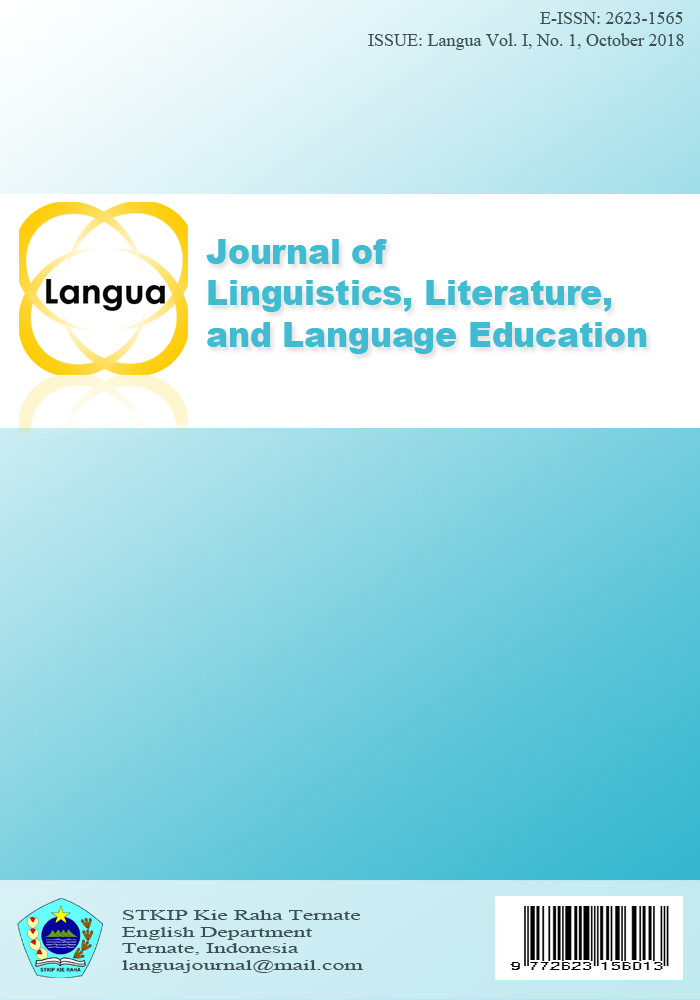Translation Errors in English-Indonesian President’s Speech Text Produced by Students of the Sixth Semester of English Education Program at STKIP Kie Raha Ternate
Abstract
English students are always taught four language skills; listening, speaking, reading and writing. Besides the skills mentioned above, there is still one of the very important aspects encouraging the foreign language in teaching and learning process, namely translation. Thus, having ability in translation becomes a primary necessity for students who learn language especially foreign language. In Indonesia for example, English taught as a foreign language. However, there are often cases where translation contains errors and if there are errors in translation, the real message of the text is not communicated well. There could be misunderstanding because of error in translation. Based on the phenomenon, the researcher was interest to the research of the translation error. The researcher focused the research in the sixth semester student of English Education Program at STKIP Kie Raha Ternate consist of 31 students, because they have gotten the lectures of Translation, so at least they have already a bit knowledge. The data were taken from 18 students only as samples. The researcher collected the data by gave the students an English text to be translated into Indonesian. The research used descriptive qualitative method because the research attempted to find their errors in translating text. It means that the research aimed to find what kinds of error they might make. In analyzed the data, the researcher identified and classified the errors based on their types. The analysis of the data showed the student errors in translating English text. Based on the data analysis, the researcher found that the students committed errors in Omission (1700 or 97.3%), Misinformation (31 or 1.8%), and Addition (16 or 0.9%).
Downloads
References
Baker, M. 1992. In other words: A course book for Translation. London: Routledge.
Bogdan, B., & Taylor, T. 2007. Metode penelitian kualitatif. Retrieved januari 9, 2014,
Brislin, R. W. 1976. Translation, Application, and Research. New York: Gardner Press.
Brown, H. D. 1980. Teaching by Principles. New Jersey; Prentice Hall Regent.
Catford, J. C. 1965. A Linguistic theory of translation; An Essay In Applied Linguistics. London: Oxford University Press.
Dulay, H., Burt, M., and Krashen, S. 1982. Language Two. Oxford:Oxford University Press.
Newmark, P. (1988). Approaches in translation, Oxford & New York: Pergamon Press.
Richard W. 1997. Translation, Application, and Research. New York: Gardner Press
Seguinot, C. (1990). Interpreting errors in translation. Meta, 35, pg 68.
Wills, W. 1982. The Science of Translation : Problems and Methods. Tubingen: Gunter
Authors who publish with Langua Journal of Linguistics, Literature, and Language Education agree to the following terms:
- Authors retain copyright and grant the journal right of first publication with the work simultaneously licensed under a Creative Commons Attribution License that allows others to share the work with an acknowledgement of the work's authorship and initial publication in Langua.
- Authors are able to enter into separate, additional contractual arrangements for the non-exclusive distribution of the journal's published version of the work (e.g., post it to an institutional repository or publish it in a book), with an acknowledgement of its initial publication in Langua.
- Authors are permitted and encouraged to post their work online (e.g., in institutional repositories or on their website) prior to and during the submission process, as it can lead to productive exchanges, as well as earlier and greater citation of published work.






